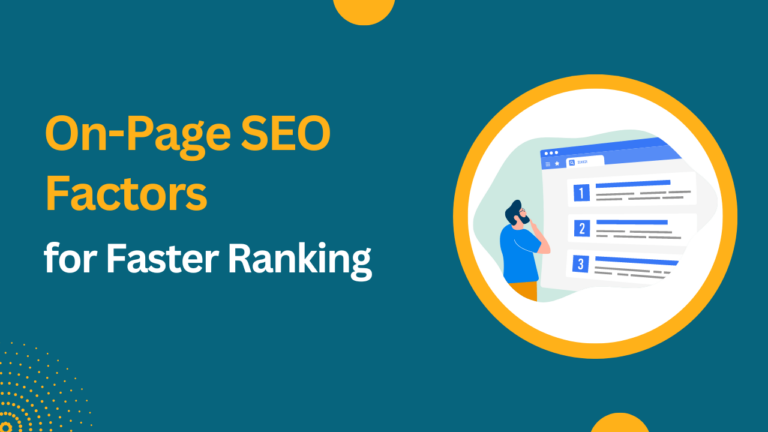In the fast-paced and highly competitive world of online business, having a well-optimized website is no longer an option, but a necessity. Technical SEO, which focuses on the backend elements of a website that affect its visibility and performance in search engines, has become more important than ever in 2023. Let’s explore the most important technical SEO factors to consider in today’s digital landscape.
In 2023, there are several key technical SEO considerations that can significantly impact your website’s visibility and rankings. In this blog post, we will explore the most important technical SEO factors to consider in 2023 and how you can optimize your website accordingly. But before that, let’s understand why technical SEO is so important in 2023.

Why Technical SEO is More Important Than Ever?
In today’s highly competitive online landscape, technical SEO plays a crucial role in determining the success of your website. Here are some reasons why technical SEO is more important than ever in 2023:
- Enhanced User Experience:
Technical SEO plays a significant role in improving the user experience on your website. Factors such as mobile optimization, page speed, and structured data help create a seamless and user-friendly browsing experience. With search engines prioritizing websites that offer a positive user experience, optimizing the technical aspects of your site ensures that visitors can easily navigate, access information, and engage with your content. - Mobile-First Indexing:
Mobile devices have become the primary means of accessing the internet, making mobile optimization a top priority. Google’s shift to mobile-first indexing means that the mobile version of your website is the starting point for determining search rankings. If your site isn’t mobile-friendly, you risk losing visibility and potential organic traffic. By implementing responsive design, optimizing mobile page speed, and ensuring a consistent user experience across devices, you can cater to the growing mobile audience and improve your chances of ranking higher in search results. - Core Web Vitals and Ranking Signals:
Google’s introduction of Core Web Vitals as ranking signals in 2021 has further emphasized the importance of technical SEO. Core Web Vitals, which include metrics like loading speed, visual stability, and interactivity, directly impact the user experience on your website. Websites that prioritize these factors are more likely to rank higher in search results and gain a competitive advantage. Monitoring and optimizing your Core Web Vitals allow you to align your site with Google’s user-centric approach and meet the evolving expectations of search engine algorithms. - Search Engine Crawling and Indexing:
Search engine bots crawl and index web pages to determine their relevance and rank them accordingly. Technical SEO factors such as XML sitemaps, proper URL structures, canonicalization, and robots.txt optimization help search engines effectively crawl and understand your website’s content. By making it easier for search engine bots to access and interpret your web pages, you increase the likelihood of your content being indexed and displayed in search results. - Website Security and Trust:
In an era where cybersecurity threats are prevalent, website security is of paramount importance. The adoption of HTTPS and the presence of SSL certificates ensure secure data transmission and protect user privacy. Search engines take website security into account when ranking pages, and a lack of proper security measures can lead to warnings or penalties. By investing in technical SEO practices that prioritize website security, you not only safeguard user data but also build trust with both visitors and search engines. - Stay Ahead of the Competition:
As the digital landscape becomes increasingly competitive, implementing technical SEO best practices can give you an edge over your competitors. By staying updated with the latest trends and optimizing your website’s technical elements, you can improve your rankings, increase organic traffic, and attract more potential customers. Ignoring technical SEO can result in missed opportunities and hinder your ability to compete effectively in search engine rankings.
Most Important Technical SEO Factors
1. Mobile-Friendly and Responsive Design:
With the majority of internet users accessing the web through mobile devices, having a mobile-friendly and responsive website is more important than ever.
Google and other search engines prioritize mobile-first indexing, meaning they primarily use the mobile version of your site to determine its rankings. To provide a seamless experience across various screen sizes, make sure that your website is optimized for mobile devices.
2. Site Structure
A well-organized site structure enhances user experience and makes it easier for search engines to crawl and understand your website’s content hierarchy. Create a logical and intuitive navigation structure with clear categories, subcategories, and internal linking.
Ensure that each page is easily accessible within a few clicks from the homepage. A well-structured site architecture can improve indexability and help search engines determine the relevance and importance of your pages.
3. Page Speed Optimization
Page speed has long been recognized as a crucial ranking factor, and in 2023, it continues to hold immense importance. Users expect websites to load quickly, and search engines take into account the loading time when ranking pages.
Compress images, minify code, leverage browser caching, and utilize content delivery networks (CDNs) to improve your website’s speed. Regularly monitor and optimize your site’s performance to provide a fast and smooth user experience.
4. Core Web Vitals
Core Web Vitals include a set of metrics that evaluate user experience on any website. Largest Contentful Paint (LCP), Cumulative Layout Shift (CLS), and First Input Delay (FID) are the three components of it.
These metrics evaluate loading, visual stability, and interactivity aspects of your web pages. In 2021, Google announced that Core Web Vitals would become ranking signals, making them a crucial consideration for SEO. Continuously monitor and optimize your website’s Core Web Vitals to enhance user experience and improve search engine rankings.
5. Crawling and Indexing
Efficient crawling and indexing of your website by search engine bots is crucial for ensuring that your content is discovered and ranked appropriately.
Ensure that your site’s robots.txt file is properly configured to allow search engines to access relevant pages while blocking access to sensitive or duplicate content. Monitor your crawl logs and use tools like Google Search Console to identify and resolve any crawling issues.
6. XML Sitemaps
XML sitemaps act as a roadmap for search engine bots, guiding them to discover and index your website’s pages effectively. Ensure that your XML sitemap is up-to-date, includes all relevant pages, and adheres to the sitemap protocol guidelines.
Regularly submit your sitemap to search engines and monitor the indexing status of your pages to identify any potential issues.
7. Structured Data and Schema Markup
Structured data and schema markup serve as valuable tools to enhance how search engines interpret and understand the content on your website. By providing explicit context and meaning to your content, you can enhance your chances of appearing in rich search results, such as featured snippets and knowledge panels.
Implement structured data using Schema.org vocabulary to highlight key information on your site and increase its visibility in search engine result pages (SERPs).
8. SSL Certificates and HTTPS
Website security is an integral aspect of SEO that cannot be overlooked. It is essential to ensure that your website has a valid SSL certificate and is accessible via HTTPS.
Secure websites inspire trust among users and search engines alike, positively impacting your search rankings. Additionally, Google Chrome and other browsers display warnings for non-secure websites, which can deter visitors and harm your organic traffic.
9. Canonicalization
Canonicalization refers to the process of specifying the preferred version of a URL when multiple versions of the same page exist. This helps prevent duplicate content issues and consolidates ranking signals for a single URL.
Use canonical tags to indicate the canonical URL for each page, ensuring that search engines understand which version to prioritize in search results.
10. Thin/Duplicate Content
Having thin or duplicate content can harm your website’s visibility and rankings. Thin content refers to pages with little or no substantial value to users, while duplicate content refers to identical or substantially similar content across multiple pages.
Conduct regular content audits to identify and consolidate thin or duplicate content. Improve and expand thin pages, and use canonical tags or 301 redirects to consolidate duplicate content and consolidate ranking signals.
11. HTTPS Status Codes
HTTPS (Hypertext Transfer Protocol Secure) is an essential security measure for websites, encrypting data transmitted between users and the server. Beyond the security benefits, the correct usage of HTTPS status codes is important for technical SEO.
Ensure that your website returns the appropriate HTTPS status codes (e.g., 200 for successful pages, 301 for permanent redirects, 404 for not found, etc.) to communicate the status of your web pages accurately. Proper usage of status codes can help search engines understand page changes, redirects, and errors, ultimately impacting your website’s visibility and user experience.
Conclusion
As search engine algorithms and user expectations evolve, staying on top of technical SEO factors becomes crucial for website owners and digital marketers. Consider implementing all the important technical SEO factors for staying ahead of the competition. By optimizing these aspects, you can enhance your website’s visibility, improve search engine rankings, and provide a better user experience in 2023 and beyond.


